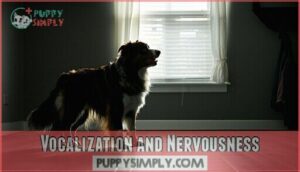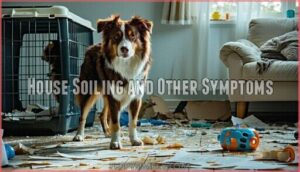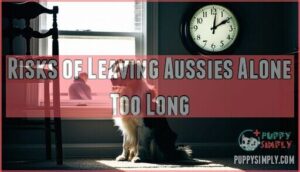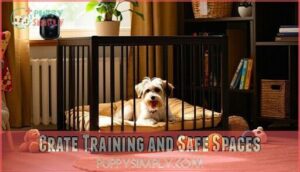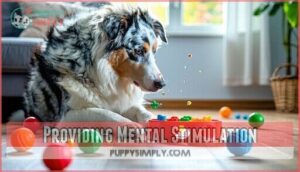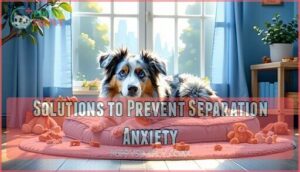This site is supported by our readers. We may earn a commission, at no cost to you, if you purchase through links.

You’ll likely notice signs of distress like destructive chewing, excessive barking, or house soiling if you push beyond their comfort zone. Puppies and senior Aussies need even shorter alone periods, while well-trained adults might handle the full 6-hour stretch.
The key isn’t just the time limit—it’s understanding why your Aussie feels anxious and what specific strategies can help them cope with your absence.
Table Of Contents
- Key Takeaways
- How Long Can Australian Shepherds Be Left Alone?
- Why Australian Shepherds Struggle With Alone Time
- Signs of Separation Anxiety in Aussies
- Risks of Leaving Aussies Alone Too Long
- Preparing Your Aussie for Alone Time
- Solutions to Prevent Separation Anxiety
- Tips for Meeting Your Australian Shepherd’s Needs
- Frequently Asked Questions (FAQs)
- What are some mental stimulation toys I can leave for my Aussie when I’m gone?
- What are signs my Aussie may be experiencing separation anxiety?
- Can Australian Shepherds live in apartments successfully?
- What age can Aussies be left alone?
- Do Australian Shepherds need constant human companionship?
- How much exercise before leaving Aussies alone?
- Are there medications for Aussie separation anxiety?
- Conclusion
Key Takeaways
- You shouldn’t leave your Australian Shepherd alone for more than 4-6 hours maximum, as these "Velcro dogs" form intense bonds and quickly develop separation anxiety when isolated too long.
- You’ll need to provide 1-2 hours of vigorous exercise and mental stimulation before leaving your Aussie alone to prevent destructive behaviors like chewing, excessive barking, and house soiling.
- You can prepare your Aussie for alone time through gradual desensitization training, crate training for a secure space, and interactive puzzle toys that keep their intelligent minds engaged.
- You should watch for escalating separation anxiety signs including destructive chewing, persistent vocalization, and indoor accidents, which can develop into serious long-term behavioral and health problems without intervention.
How Long Can Australian Shepherds Be Left Alone?
You shouldn’t leave your Australian Shepherd alone for more than 3-4 hours at a time, as these "Velcro dogs" form strong bonds with their owners and quickly develop separation anxiety.
Australian Shepherds are Velcro dogs who bond intensely with their owners—leaving them alone too long triggers destructive separation anxiety
While some well-adjusted adult Aussies might handle slightly longer periods, most will start showing stress behaviors like destructive chewing, excessive barking, or house soiling when left alone too long.
Recommended Maximum Alone Time
Australian Shepherds shouldn’t be left alone for more than four to six hours daily. Extended periods beyond this timeframe can trigger separation anxiety and behavioral issues.
Here’s what you need to know about Alone Time Limits:
- Puppies and adolescents: Maximum 2-4 hours due to developmental needs
- Well-trained adults: Up to 6 hours with proper exercise beforehand
- Daily recommendation: Arrange Dog Sitter Benefits or midday breaks for full workdays
Age and Temperament Considerations
Your puppy’s age-journey shapes their tolerance for solitude. Puppy socialization requires shorter alone periods, while adult temperament allows extended independence. Senior care needs adjust expectations as energy shifts.
| Life Stage | Max Alone Time | Key Considerations | Training Focus |
|---|---|---|---|
| Puppy (8-16 weeks) | 1-2 hours | Bladder control, anxiety prevention | Basic crate training, short departures |
| Adolescent (4-18 months) | 3-4 hours | Energy peaks, boundary testing | Consistent routines, mental stimulation |
| Adult (2-7 years) | 4-6 hours | Established temperament, full capacity | Reinforcement training, exercise balance |
| Senior (7+ years) | 3-5 hours | Health changes, comfort needs | Gentle adjustments, medical monitoring |
Individual breed personality varies markedly. Some Australian Shepherds develop stronger independence, while others remain velcro-dogs throughout life. Monitor your dog’s separation anxiety responses and adjust accordingly.
Miniature and Standard Aussie Differences
When you’re choosing between breed variations, you’ll notice key differences that affect alone time tolerance. Miniature Australian Shepherds often adapt better to smaller spaces but share the same separation anxiety tendencies as their standard-sized cousins.
Here are the main differences to examine:
- Size Comparisons: Standards need more physical space and exercise before being left alone
- Training Methods: Both respond to consistent routines, but minis may require gentler approaches
- Grooming Needs: Standards shed more, creating additional cleanup concerns during alone periods
- Health Differences: Both breeds face similar anxiety-related issues when isolated too long
Understanding these breed variations helps you plan appropriate Australian Shepherd care strategies for your specific dog’s needs.
Why Australian Shepherds Struggle With Alone Time
Your Australian Shepherd’s struggle with alone time isn’t a character flaw—it’s hardwired into their DNA. These dogs were bred to work alongside humans all day, making solitude feel unnatural and stressful for most Aussies.
Breed History and Herding Instincts
For centuries, working alongside shepherds shaped the Australian Shepherd breed’s DNA. These Herding Dog Breeds descended from Shepherd Ancestors in Spain’s Basque Roots, bringing powerful Herding Instincts to American Heritage ranches.
The Breed Development occurred entirely in North America, where Herding Origins created dogs hardwired to stick close and work as a team—explaining why your Australian Shepherd becomes your shadow.
Social and Emotional Needs
Beyond their herding heritage, these dogs crave emotional support and canine companionship that goes far deeper than basic pet ownership. Your Aussie’s mental wellness depends on consistent social bonding, making leaving Australian Shepherds alone particularly challenging when attachment issues develop.
Consider these core social needs:
- Daily human interaction – Multiple meaningful touchpoints throughout each day
- Consistent emotional connection – Regular bonding activities that strengthen your relationship
- Social stimulation – Interaction with other dogs and people beyond the household
- Predictable companionship routines – Scheduled time together that your dog can anticipate
- Responsive emotional support – Recognition and response to your dog’s emotional cues
Australian Shepherds require regular high energy exercise daily activity needs to stay happy and healthy. Without proper socialization training and separation anxiety solutions, your Aussie’s need for connection becomes overwhelming during solo periods.
Common Behavioral Reactions
When you leave your Aussie alone too long, you’ll witness their distress through specific Behavioral Patterns. Common Emotional Responses include destructive chewing, excessive barking, and house soiling.
These Stress Signals reveal their struggle with Leaving Australian Shepherds Alone. Understanding these Anxiety Triggers helps you recognize when your dog needs better Coping Mechanisms and targeted dog separation anxiety interventions.
Signs of Separation Anxiety in Aussies
Recognizing separation anxiety in your Australian Shepherd is essential for addressing the problem before it worsens. The signs are often obvious and can range from mild nervousness to destructive behaviors that affect both your dog’s well-being and your home.
Destructive Behaviors
Your Aussie’s destructive behaviors reveal the depth of their separation anxiety when leaving dogs alone becomes routine. These intelligent dogs channel their stress into physical outlets that can quickly escalate beyond simple mischief.
Common destructive behaviors include:
- Chewing Habits – Furniture, shoes, and household items become targets within 2-4 hours of being left unsupervised.
- Digging Issues – Backyard excavation around fences and foundation edges increases by 47% during alone time.
- Furniture Damage – Scratching at doors and windows often leads to broken trim and torn weather-stripping.
- Clawing Behavior – Deep scratches near entry points affect over 50% of owners who leave their Aussies for six-plus hours.
These destructive behaviors aren’t spite—they’re your dog’s way of coping with overwhelming anxiety and boredom.
Vocalization and Nervousness
Your Aussie’s vocal protests reveal deep emotional distress when left alone. Whining Behavior and excessive Barking Patterns signal escalating Anxiety Signs rather than simple attention-seeking. These Nervous Traits and Stress Reactions indicate your dog’s struggle with solitude.
Australian Shepherd Behavior includes persistent howling that can last hours, creating problems with neighbors while highlighting your pet’s genuine need for companionship and mental stimulation.
House Soiling and Other Symptoms
Your Australian Shepherd’s stress can manifest in messy ways beyond typical anxiety signs. Indoor urination issues often occur even after proper housebreaking and recent bathroom breaks. These soiling causes stem from overwhelming emotions rather than physical needs.
Watch for destructive behavior patterns like excessive scratching at doors or windows. Crate training helps with accident prevention while providing security.
Mental stimulation through interactive toys reduces dog boredom prevention needs during separation periods.
Risks of Leaving Aussies Alone Too Long
When you leave your Australian Shepherd alone for extended periods, you’re setting the stage for escalating anxiety that can spiral into serious behavioral and health problems.
What starts as mild restlessness can quickly develop into destructive habits, chronic stress responses, and even physical health issues that require professional intervention.
Escalating Anxiety and Stress
When anxiety spirals out of control, your Aussie faces mounting stress that compounds quickly. Prolonged isolation creates a cascade of negative emotions that can overwhelm even well-adjusted dogs. Here’s how escalating anxiety manifests:
- Anxiety Triggers multiply as your dog associates more situations with abandonment
- Stress Management becomes impossible without proper Emotional Support systems
- Canine Calming techniques lose effectiveness as panic responses intensify
- Owner Responsibility includes recognizing when dog boredom prevention isn’t enough
- Dog mental stimulation and dog exercise needs can’t compensate for severe separation distress
Without intervention, behavioral commands and crate training become ineffective against overwhelming panic responses.
Long-Term Behavioral Problems
When behavior problems take root, they’re like weeds in your backyard—tough to eliminate once established. Up to 22% of dogs with separation issues develop chronic destructive habits that persist even after initial stress management efforts. Addressing these issues often requires understanding of separation anxiety symptoms and triggers.
| Behavioral Patterns | Anxiety Triggers | Stress Management |
|---|---|---|
| Chronic chewing, digging | Extended social isolation | Regular exercise routines |
| Training regression | Schedule disruptions | Mental stimulation activities |
| Aggressive reactivity | Lack of crate training | Professional intervention |
These ingrained behavior problems create emotional distress that compounds over time, requiring intensive behavioral modification beyond basic dog mental stimulation.
Health and Safety Concerns
Extended isolation can trigger severe mental health deterioration in your herding dog, creating dangerous situations that demand immediate attention. Understanding dog separation anxiety is vital, as it involves separation anxiety issues.
- Physical Risks: Destructive chewing can cause choking hazards or intestinal blockages requiring emergency surgery.
- Mental Health: Chronic anxiety triggers stress-related conditions affecting the immune system and overall wellbeing.
- Emergency Preparedness: Unattended dogs can’t signal medical emergencies or respond to household dangers.
- Safety Precautions: Anxiety triggers include loud noises that may cause panic-induced injuries without supervision.
Preparing Your Aussie for Alone Time
Success starts with proper preparation when you’re getting your Australian Shepherd ready for solo time. The key is creating a structured approach that caters to their exercise needs, provides mental engagement, and establishes a secure environment before you walk out the door.
Crate Training and Safe Spaces
Creating a secure enclosure becomes your Australian Shepherd’s personal sanctuary. Start crate introduction gradually, making this dog den inviting with comfortable bedding and favorite toys. Your Aussie’s safe zone should feel like home, not punishment.
Use positive reinforcement during crate training sessions. Consider adding calming spaces with a pet camera for monitoring, ensuring your dog’s secure enclosure remains stress-free.
When setting up the space, consider investing in proper dog crate equipment to guarantee your dog’s safety and comfort.
Providing Mental Stimulation
Several puzzle toys can transform your Aussie’s alone time into productive brain exercises. Treat dispensing balls engage dogs for 30+ minutes per session, while scent work games tap into their herding instincts.
Interactive games with adjustable difficulty prevent boredom and reduce anxiety by 54%. Rotate toys regularly to maintain mental stimulation and challenge their problem-solving abilities effectively.
Exercise and Routine Establishment
Establishing Daily Exercise Plans before leaving your Australian Shepherd alone for four hours creates a foundation for success. Regular Exercise sessions—combining physical activity and mental stimulation through interactive games—tire your dog constructively.
Consistent Routine Scheduling helps your Aussie anticipate alone time, reducing anxiety. Well-exercised dogs adapt better to solitude, making Playtime Management essential for peaceful separations.
Solutions to Prevent Separation Anxiety
Prevention strategies can help your Australian Shepherd handle alone time without developing destructive behaviors or anxiety. These approaches focus on building confidence and creating positive associations with solitude through gradual training and environmental management.
Gradual Desensitization Techniques
Gradual desensitization methods help your Velcro dog adjust to owner absence through small steps. Start with seconds-long departures, then slowly increase duration over weeks. Practice separation preparation by picking up keys without leaving. Combine calming strategies like consistent routines with alone time training. This Australian Shepherd-focused approach builds confidence while reducing anxiety through patient, methodical exposure.
Interactive Toys and Entertainment
Interactive toys transform your Australian Shepherd’s alone time from anxiety-inducing to engaging. These mental stimulation tools redirect energy into productive activities, preventing destructive behaviors while satisfying their intelligent minds.
Using the right puzzle toy options can make a significant difference in their mental health.
- Puzzle Toys – Challenge your Aussie’s problem-solving skills with treat-dispensing puzzles that keep minds busy for hours.
- Interactive Feeding – Turn mealtime into playtime with slow-feeder bowls and food-dispensing toys that mimic hunting instincts.
- Sensory Games – Rotate different textured toys and dog puzzles to maintain novelty and prevent boredom during extended periods alone.
Professional Help and Dog Daycare
When interactive toys aren’t enough, professional support can make all the difference. Dog sitters, pet sitters, or dog walkers provide midday breaks that prevent anxiety buildup. Dog daycare centers offer socialization and supervision for longer absences. For persistent separation issues, canine counselors and dog trainers develop personalized behavior modification plans. Pet hotels serve as temporary solutions during extended trips, ensuring your Aussie receives proper care and attention.
Understanding separation anxiety is vital for addressing the issue effectively in Australian Shepherds.
Tips for Meeting Your Australian Shepherd’s Needs
Meeting your Australian Shepherd’s physical and mental needs prevents separation anxiety and creates a well-balanced dog. Proper exercise, training, and social interaction form the foundation of a healthy relationship that makes alone time manageable.
Daily Exercise Requirements
Your Australian Shepherd needs 1-2 hours of vigorous physical activity daily to prevent behavioral issues. Without proper exercise routines, these active dogs become destructive and anxious, making alone time even more challenging for your household.
Here are essential daily walks and playtime needs:
- Morning and evening walks – Two 45-minute brisk sessions provide baseline Australian Shepherd exercise requirements.
- High-intensity fetch or frisbee – Satisfies herding instincts while building stamina and focus.
- Mental stimulation activities – Puzzle toys and nose work prevent boredom-related destruction.
- Swimming or hiking – Varied terrain challenges different muscle groups and maintains interest.
- Dog training sessions – Incorporate obedience work into exercise for dual physical and mental benefits.
Investing in proper Dog Exercise Equipment can help meet the daily exercise needs of your Australian Shepherd.
Socialization and Training
Proper socialization and training form the backbone of your Australian Shepherd’s well-being. Start with positive reinforcement techniques that work with their herding instincts rather than against them. Focus on canine communication through consistent commands and reward-based behavior modification.
Early dog socialization prevents anxiety issues, while ongoing training methods help channel their intelligence productively. This approach ensures a confident, well-adjusted companion.
Maintaining a Healthy Relationship
Through consistent bonding techniques and emotional support, you’ll strengthen owner attachment while nurturing your Australian Shepherd’s canine empathy. Relationship building requires understanding their herding instincts and providing adequate socialization, exercise, and training.
This creates trust that makes alone time manageable, transforming your Aussie from a clingy companion into a confident, well-adjusted partner who thrives independently. By focusing on proper dog care techniques, you can guarantee your Australian Shepherd leads a happy and healthy life.
Frequently Asked Questions (FAQs)
What are some mental stimulation toys I can leave for my Aussie when I’m gone?
Puzzle feeders and treat-dispensing balls challenge your dog’s problem-solving skills while rewarding them with snacks. Rotate Kong toys stuffed with peanut butter, snuffle mats, and interactive puzzle boards to keep their minds engaged during alone time.
What are signs my Aussie may be experiencing separation anxiety?
Roughly 14-20% of dogs suffer from separation anxiety, with your Aussie being particularly vulnerable.
You’ll notice destructive chewing, scratching furniture, excessive barking or whining, indoor accidents despite recent potty breaks, and nervous behaviors like cowering when you return home.
Can Australian Shepherds live in apartments successfully?
Australian Shepherds struggle in apartments due to their high energy levels and need for space. You’ll face challenges meeting their exercise requirements and mental stimulation needs in cramped quarters, potentially leading to destructive behaviors.
What age can Aussies be left alone?
Young Aussies under 18 months shouldn’t be left alone longer than their age in months plus one hour.
You’ll find adult shepherds handle solitude better, but even mature dogs struggle beyond 3-4 hours without developing anxiety.
Do Australian Shepherds need constant human companionship?
While Australian Shepherds don’t need constant human companionship, they’re "Velcro dogs" who crave interaction and can develop separation anxiety when left alone for extended periods beyond three to four hours regularly.
How much exercise before leaving Aussies alone?
Before leaving your Aussie alone, provide at least 30-60 minutes of vigorous exercise like running, fetch, or agility training. A tired dog settles better and experiences less anxiety during separation periods.
Are there medications for Aussie separation anxiety?
Yes, veterinarians can prescribe anti-anxiety medications like fluoxetine or clomipramine for severe separation anxiety.
You’ll need a professional evaluation first, as medications work best when combined with behavioral training and environmental changes.
Conclusion
Sure, your Australian Shepherd’s separation anxiety isn’t a character flaw—it’s basically their resume showing they’re overqualified for the "independent pet" position. Understanding how long can Australian shepherds be left alone helps you create realistic expectations and practical solutions.
With proper preparation, mental stimulation, and gradual training, you’ll transform those stressful departures into manageable routines. Remember, meeting their exercise and social needs isn’t just kindness—it’s essential for a balanced, happy Aussie who can handle your necessary absences.
- https://articles.hepper.com/how-long-can-australian-shepherds-be-left-alone/
- https://www.australian-shepherd-lovers.com/australian-shepherd-alone-time-how-long-is-too-long.html
- https://www.greencrossvets.com.au/pet-library/dogs/breed-guides/australian-shepherd-owners-guide/
- https://www.akc.org/expert-advice/health/treating-dog-anxiety/
- https://worldanimalfoundation.org/dogs/high-separation-anxiety-dogs/



